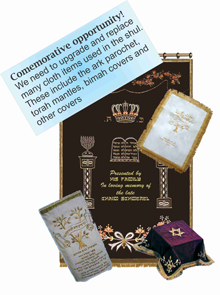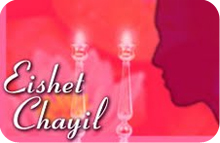The story of Chanukah happened more that 200 years before the Second Temple was destroyed by the Romans (which by the way was long after the story of Purim happened) At the time of the Chanukah story, Jews living in Israel were living under Greek rule.
The Greeks wanted us to adopt their culture. The Jews were unwilling to give in to the Greeks and were even ready to risk their lives to defend their principles.
A revolt erupted in the village of Modi’in in the year 167 B.C.E. When a messenger of the King insisted on a pig being slaughtered and offered to a Greek god by the Jews of the village. Matityahu, son of Yochanan, the Kohen Gadol of the Hasmonean family, killed the messenger, and broke down the Altar. At this point, through Divine intervention, Matityahu and his 5 sons – Yonatan, Shimon, Yehuda, Elazar and Yochanan – were able to rally a fighting force of “Hasmoneans” (Maccabim) to fearlessly do battle against the Greek armies, thereby overcoming them. Their motives were ideological and spiritual – they wanted to serve G-d and His Torah, and free themselves from the Greek paganistic culture.
The Greeks had defiled the Temple. The Temple is the link of the Jew with the spiritual. Far more than a place to worship and sacrifice the Temple was like a miniature Garden of Eden where Rules of Nature were dominated by Rules of Spirit. Hashem’s presence the Shechina emanated from the Temple.
Among the many holy vessels in the Temple was the Menorah. The Menorah was a candelabra with seven branches which stood 6b foot high and was made of gold. The seven branches represented Hashem’s creation of the world in 7 days. The Menorah was hewed out of one piece of Gold. This was particularly significant. It reminded us that it was ONE G-d responsible for the whole creation. This was the exact opposite of what the Greeks believed, namely that there were many G-ds, each one in control of a different power of nature e.g. god of water, god of fire.
It is for this reason in particular that the Greeks defiled the Menorah and discarded all the special olive oil that was used to kindle the lights of the Menorah. On the 25th Kislev, Yehuda Ha Maccabi managed to recapture the Temple, and went about purifying and cleansing it, so that it could be rededicated.
When they entered the Temple, they set about looking for oil to relight the Menorah. Only one jar of oil, sufficient for one day was found and it miraculously lasted for eight days every year.
The sages of that generation established that the eight days, beginning with the 25th Kislev, became days of rejoicing for future generation, with the reciting of Hallel and the kindling of lights to publicize the miracle – Chanukah. Indeed the word Chanukah can be split up into two elements.
Channu – They rested from their enemies.
Kah – which has the numerical value of 25.
THE PRACTICAL OBSERVANCE OF CHANNUKAH:
The laws of Chanukah are found in the Shulchan Aruch. The Shulchan Aruch is a set of books containing all the laws that a Jew needs to know. It was written by Josef Karo who lived from 1488 – 1575.
WHERE DO WE LIGHT THE CHANNUKIAH?
IN Biblical times the Channukiah was placed in the entrance opening to the street on the outside. Today we light the candles indoors. It should be lit by a window facing the street in order to publicize the miracle.
WHEN DO WE LIGHT THE CHANNUKIAH?
A person may not light the candles before sunset. The candles must be lit after dark or at sunset according to ones custom.
WHO LIGHTS THE CHANNUKIAH AND HOW IS IT DONE?
The basic law only requires that a single candle be lit each night for each household. Today we have the custom of each person lighting their own Channukiah and of lighting an additional candle for each night of Chanukah.
On the first night, three blessings are recited and from the second night onwards only two blessing are said.
Assuming we are facing a Channukiah, the first night we light the candle at the very right and each night we fill the Channukiah from right to left.
However, the order of lighting the candles is from left to right (i.e. we light the new candle first). After all the candles are lit, we say a prayer Haneirot Hallalu.
Some have the custom of saying this after the candle is lit, while you are still lighting the remaining candles.
HOW LONG MUST THE CANDLES BURN FOR?
The candles must burn for at least half an hour. On Friday night, the Chanukah candles are lit before Shabbat candles. Please remember to light bigger Chanukah candles on Friday night as Shabbat candles and Chanukah candles are lit before sunset and the Chanukah candles still need to burn for half an hour after dark.
ADDITIONS TO THE SERVICE DURING CHANNUKAH:
During the 8 days of Chanukah we say full Hallel during Shacharit. The Torah is also read each morning. A special Prayer Al Hanissim “for the miracles” is added each time we daven the Amidah. This prayer is also added to Birkat Hamazon during the Festival.
GENERAL CUSTOMS:
Levivot (potato latkes) and sufganiyot (doughnuts) are symbolic foods which are eaten on Chanukah. This is because they are fried with oil thus reminding us of the miracle of the oil which lasted for eight days.
D’mei Chanukah (Chanukah Gelt) – gifts of money are given to the children to enhance their enjoyment of the Festival.
Mischakei Sivivon (Spinning the dreidel game) – while the lights are burning we sing Chanukah songs and eat latkes and doughnuts. The children play a game with a spinning top or dreidal, which has 4 sides. In Israel, the four letters on each side spell out: Nes Gadol Haya Po. In the Gola (Diaspora), the dreidals are made with the same letter except the Pey is substituted with the Shin (sham – in Israel)
This game is a game of chance, played with the children’s Chanukah gelt. Each participant pools his money in the center. Each player has his turn to spin the dreidal. If it lands on Nun, he gets nothing; if it lands on Gimmel he wins the Ganse lot. If on Hey then he wins half and if on Pay he puts in. <Many have the custom to give out nuts in their shells in addition to or instead of Chanukah gelt. These nuts are used to play various games such as odds and evens and even marble games.
(THANKS TO THE S.A. BOARD OF JEWISH EDUCATION FESTIVAL FACT SHEETS for some of the above material.)







